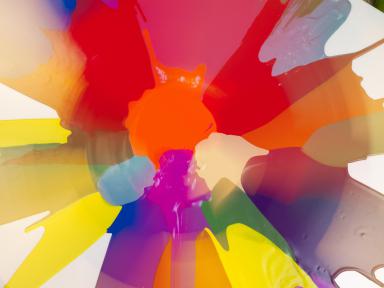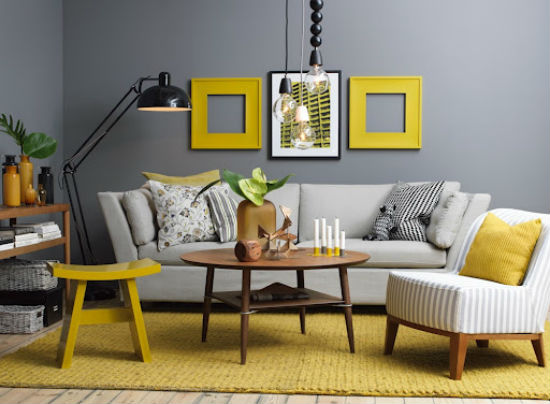Living a good and comfortable life at home is not only a result from good furniture, enormous TV set or other entertaining home modules, which make life filled with things and information.
Since we do have a choice when deciding what kind of home would we like to have, the opportunities become numerous. Hence it becomes a bit harder to recognize our private outlook for the dwelling we want to have. But before you start all the long process of putting your house together you should think of something very important. And that important thing is colors and their psychological role over consciousness and mind.
Colors
They definitely can affect people in many ways. It all depends on age, gender, ethnic background or even climate. Certain colors (or groups of colors) tend to get a similar reaction from most people; the variations come from the shades or tones used. This is why it’s so important to choose colors very wisely when it comes to decorating.
Just do not think about any kinds of trends. When we talk about colors, this is the last thing that has to concern you. Being modern is nice, but feeling well at home is better.
Combinations
Color trends will come and go. The people who live in a home make it beautiful by choosing colors that reflect their preferences and personalities. The trick is to blend the colors you like into a soothing-the-soul combination.
Choosing color combinations is one of the most intimidating steps for beginners. Color has the power to change the shape and size of furnishings, as well as the shape and size of the room itself. Selecting colors is not difficult if you gear-up yourself with some basic information about color and its effects. It’s important, it’s big, it’s healthy psychology.
 The importance of choice
The importance of choice
You shouldn’t forget that each color reflects on the consciousness of people. It has that special value, which has to be considered before choosing the colors of the walls at home, the carpet or the furniture. You should always, remember always, think about how certain colors make you feel. And you exactly. Different color palettes can influence any emotion, from tranquility, from happiness to rage. To create peace and harmony in your home, choose your colors wisely. Some colors in large amounts might have the opposite effect on you and your loved ones in a unexpected way.
Moods
It is absolutely normal to ask yourself what is the color for you and the inhabitants of your home. Hence you could use some help and need answering these questions. You can take a good look at some magazines, decorating books, and websites for ideas. Let the textiles be your guide as well. Fabrics, carpeting, furniture and tile are available in a more limited range of colors than paint, cause most of the time you buy them directly through the market. So choose them first and then decide on your paint color.
Once you find something you like, you should limit the number of colors in a room to no more than three or four. If you choose too many colors, this can make a room look busy. Paint is fairly inexpensive and transforms a room more quickly than anything else, so you can afford to experiment a little and play along. But too much.
Basically colors act in three ways: active, passive and neutral. You can easily match every room’s colors to your personal desires, and to the room’s purpose. Light colors are expansive and airy, making rooms seem larger and brighter, which is great if you search for this kind of effect. Dark colors are sophisticated and warm. They give large rooms a more intimate appearance and a private heavy look.
The best color for you
There are some basic qualities of different colors, which will help you to decide what is yours.
Red
It raises a room’s energy level up. Being probably the most intense color, it pumps the adrenaline like no other. It is a good choice when you want to mix excitement, particularly at night. In the living room or dining room, red draws people together and stimulates conversation, that’s a fact. In an entryway, it creates a strong first impression.
In many ways red is connected to blood and has been shown to raise blood pressure and speed respiration and heart rate. It is usually considered too stimulating for bedrooms, but if you’re typically in the room only after dark, you’ll be seeing it mostly by artificial lamplight. Hence the color will appear muted, rich and elegant.
Yellow
This vivid color captures the joy of sunshine and communicates happiness. It is an excellent choice for the kitchen, the dining room and the bathroom, where it is energizing and uplifting. In halls, entries and small spaces, yellow can feel expansive and welcoming.
Even though yellow although is a cheery color, it is not a good choice for main color schemes. Be careful! Studies show that people are more likely to lose their temper in a yellow interior. The strange thing is that babies also seem to cry more in yellow rooms. In large amounts, this color tends to create feelings of frustration and anger. In chromotherapy, yellow is believed to stimulate the nerves and purify the body.
Blue
It is said to bring down blood pressure and slow respiration and heart rate. That is why it is considered calming, relaxing and serene, and it is a good idea to use it for bedrooms and bathrooms.
A pastel blue that looks pretty on the paint chip can come across as unpleasantly chilly on the walls and furnishings, however, especially in a room that receives little natural light. If you opt for a light blue as the primary color in a room, you should balance it with some warm hues for the furnishings and fabrics.
Blue is known to have a calming effect when used as the main color of a room — but go for softer shades. Dark blue has the opposite effect, evoking feelings of sadness.
Green
It is considered the most restful color for the eye. It combines parts of the refreshing quality of blue and the cheerfulness of yellow. This way green is suitable for almost any room on the house. In the kitchen, green cools things down; in a family room or living room, it encourages unwinding but has enough warmth to promote comfort and togetherness.
Use it as a main color in decoration and green will show a calming effect. It is believed to relieve stress by helping people relax. It is also believed to help with fertility.
Purple
I its darkest values, purple is rather rich, dramatic and sophisticated color. It is associated with luxury and creativity. It can give your home a scheme depth if it’s used as a secondary decor. Lighter versions of purple, such as lavender and lilac, bring the same restful quality to bedrooms as blue does, but without the risk of feeling chilly.
Orange
It evokes excitement and enthusiasm in souls. While not a good idea for a living room or for bedrooms, this color is great for an exercise room for example. Orange will bring out all the emotions that you need released during your fitness training at home. In ancient cultures, orange was believed to heal the lungs and increase energy levels.
Neutral colors
These are mainly white, black, gray and brown. They are basic to the decorator’s tool kit. All-neutral schemes fall in and out of fashion, but their virtue lies in their flexibility. Black is best used in small doses as an accent with other colors. Indeed, some experts maintain that every room needs a touch of black to ground the color scheme and give it depth including contrast.
So in few words it’s important that you distinct and in the same time connect your desires for colors at home with the practical values of them. Because the most important is to feel absolutely comfortable and energized when being at home.





